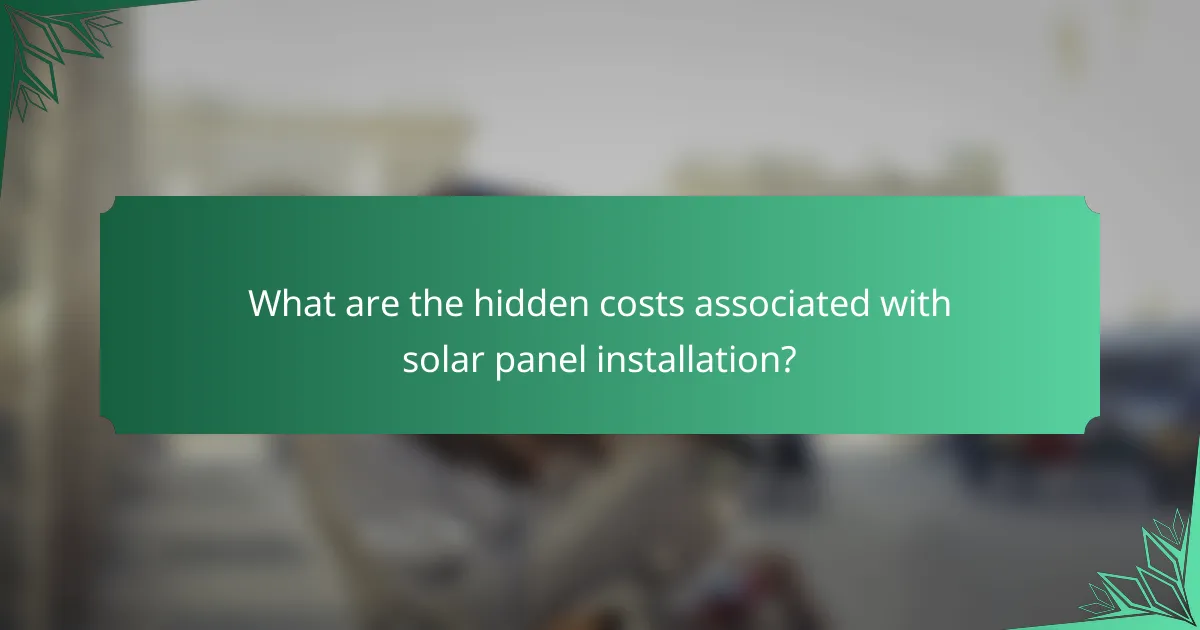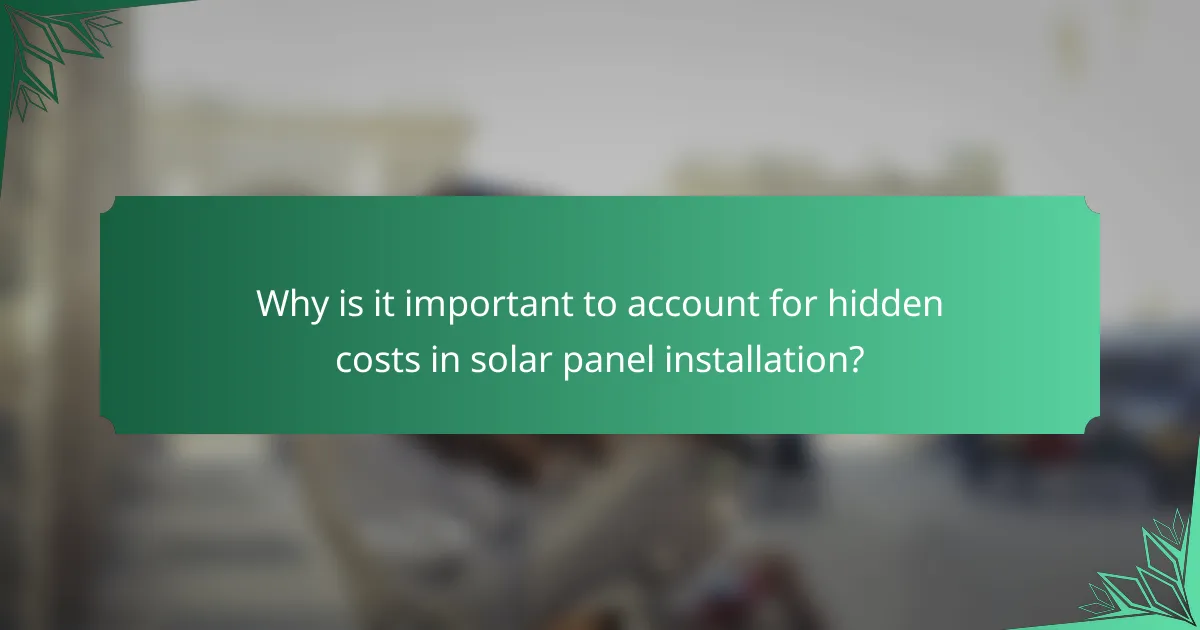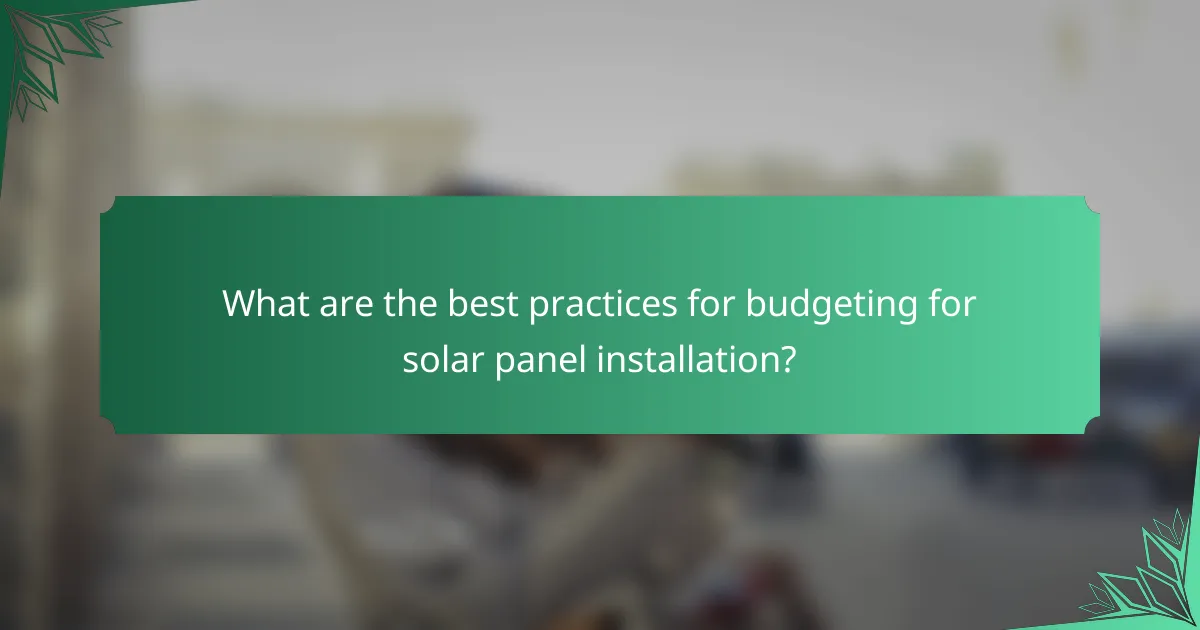
What are the hidden costs associated with solar panel installation?
Hidden costs associated with solar panel installation include permitting fees, inspection costs, and potential upgrades. Permitting fees can vary widely by location, sometimes reaching several hundred dollars. Inspection costs are also necessary to ensure compliance with local codes, which can add another few hundred dollars. Home upgrades may be required to support solar systems, such as electrical panel upgrades. These upgrades can range from $1,000 to $3,000 depending on the home’s existing infrastructure. Additionally, maintenance costs for solar panels should be factored in, typically around $100 to $300 annually. Lastly, some homeowners may face unexpected costs related to roof repairs or replacements before installation. These hidden costs can significantly impact the overall budget for solar panel installation.
How do permitting fees impact the overall cost of solar panel installation?
Permitting fees significantly increase the overall cost of solar panel installation. These fees can range from a few hundred to several thousand dollars, depending on the location and complexity of the project. For instance, in some states, permitting fees can account for 5% to 10% of the total installation cost. This increase affects the return on investment for homeowners. Additionally, the need for multiple permits can further elevate costs, as each permit may require separate fees. In summary, permitting fees are a crucial hidden cost that impacts the financial feasibility of solar panel projects.
What factors influence the cost of permits for solar panel installation?
The cost of permits for solar panel installation is influenced by several factors. Local government regulations play a significant role in determining permit fees. Different municipalities have varying permit requirements and associated costs. The complexity of the installation also affects the permit cost. More intricate systems may require additional inspections, raising fees. The size of the solar installation can influence costs as well. Larger systems may incur higher permit fees due to increased scrutiny. Additionally, the type of solar technology used may lead to different permit costs. Certain technologies may have specific regulations that impact fees. Lastly, the location of the installation can affect costs. Areas with higher demand for solar may have different fee structures. These factors collectively determine the overall cost of permits for solar panel installation.
How can homeowners estimate permitting costs?
Homeowners can estimate permitting costs by researching local regulations and fees. Each municipality has specific fees associated with building permits. Homeowners should check their city or county’s website for a fee schedule. They can also contact the local building department for detailed information. Additionally, homeowners can consult with solar installation companies for estimates. These companies often have experience with permitting and can provide insights into costs. Local averages for permitting fees can range from $100 to $2,000, depending on the project size and location. Understanding these factors helps homeowners budget accurately for solar panel installation.
What inspection fees should homeowners expect during solar panel installation?
Homeowners can expect inspection fees to range from $100 to $500 during solar panel installation. These fees cover various inspections required by local regulations. Inspections typically include electrical, structural, and system performance assessments. Costs may vary based on location and the complexity of the installation. In some areas, additional fees may apply for permit inspections. Homeowners should consult with their solar installer for specific fee structures. Understanding these costs helps in budgeting for the overall installation process.
What types of inspections are required for solar panel installations?
Solar panel installations require several types of inspections. These include electrical inspections, structural inspections, and final inspections. Electrical inspections ensure that all wiring and connections meet safety standards. Structural inspections verify that the roof can support the solar panel system. Final inspections confirm that the installation complies with local codes and regulations. These inspections help ensure safety and efficiency in solar energy systems. Local building departments or certified inspectors typically conduct them.
How do inspection fees vary by location and project size?
Inspection fees vary significantly based on location and project size. In urban areas, fees tend to be higher due to increased demand and regulatory requirements. For example, cities may charge up to 50% more than rural areas. Project size also influences fees; larger installations typically incur higher inspection costs. A small residential solar project might face fees around $200, while larger commercial projects could exceed $1,000. Local regulations and the complexity of the project further impact these fees. Thus, both geographic and project-specific factors are crucial in determining inspection costs.
What upgrades may be necessary during solar panel installation?
Upgrades necessary during solar panel installation may include electrical panel upgrades, wiring enhancements, and roof reinforcements. Electrical panel upgrades ensure compatibility with the new solar system. Older panels may not handle the increased load from solar energy. Wiring enhancements may be needed to support the additional electrical flow. This is important for safety and efficiency. Roof reinforcements may be required if the structure cannot support the weight of the solar panels. These upgrades can incur additional costs, which should be factored into the overall budget for installation.
How do system upgrades affect the total installation cost?
System upgrades can significantly increase the total installation cost of solar panel systems. Upgrades may involve enhanced equipment, such as higher-capacity inverters or additional panels. These components often come with higher price tags compared to standard options. Furthermore, installation complexity can rise with upgrades, leading to increased labor costs. For instance, retrofitting existing systems to accommodate new technology may require additional labor hours. Additionally, local regulations may necessitate further inspections or permits for upgraded systems, adding to overall expenses. According to the Solar Energy Industries Association, the average cost of solar installations can rise by 10-30% with significant upgrades.
What are common upgrades that homeowners might need to consider?
Common upgrades that homeowners might need to consider include electrical panel upgrades, roof reinforcements, and energy-efficient windows. Electrical panel upgrades ensure the system can handle the additional load from solar panels. Roof reinforcements may be necessary to support the weight of solar installations. Energy-efficient windows can enhance overall energy savings when combined with solar power. According to the U.S. Department of Energy, upgrading these systems can improve energy efficiency and long-term savings.

Why is it important to account for hidden costs in solar panel installation?
It is important to account for hidden costs in solar panel installation because they can significantly impact the overall budget. Hidden costs include permitting fees, inspection fees, and potential system upgrades. These expenses can add thousands of dollars to the initial investment. For instance, permitting fees can range from $100 to $2,000 depending on the location. Inspection fees can also vary, typically costing between $100 and $500. Additionally, system upgrades may be necessary to meet local codes, which can further increase costs. Failing to consider these hidden expenses may lead to financial strain and project delays. Accurate budgeting requires a comprehensive understanding of all potential costs involved in solar panel installation.
How can hidden costs impact the return on investment for solar energy?
Hidden costs can significantly reduce the return on investment (ROI) for solar energy. These costs may include permitting fees, inspection fees, and necessary upgrades. Each of these expenses can add hundreds to thousands of dollars to the overall project cost. For instance, permitting fees can vary by location and may not be included in initial estimates. Inspection fees are often required to ensure compliance with local regulations, adding further costs. Additionally, upgrades to the electrical system may be necessary for compatibility with solar technology. Studies indicate that these hidden costs can lower the ROI by up to 30%. This reduction emphasizes the importance of considering all potential expenses before investing in solar energy.
What strategies can homeowners use to manage hidden costs effectively?
Homeowners can manage hidden costs effectively by budgeting for all potential expenses upfront. This includes estimating costs for permits, inspections, and upgrades. Researching local regulations helps identify required permits and associated fees. Obtaining multiple quotes from contractors provides a clearer picture of installation costs. Setting aside a contingency fund for unexpected expenses is also advisable. Regularly reviewing project costs against the budget helps maintain financial control. Staying informed about available incentives can reduce overall expenses. Engaging with experienced professionals can uncover hidden costs early in the planning process.

What are the best practices for budgeting for solar panel installation?
The best practices for budgeting for solar panel installation include detailed planning, considering all costs, and obtaining multiple quotes. Start by estimating the total system cost, which typically ranges from $15,000 to $25,000 for residential installations. Factor in hidden costs such as permitting fees, which can be $100 to $2,000, and inspection fees, averaging around $200 to $500. Additionally, consider potential upgrades to your electrical system, which may add $1,000 to $3,000 to the total cost. Research local incentives and tax credits, as they can significantly reduce the overall expense. Finally, consult with several solar providers to compare offers and ensure you are getting the best value for your investment.
How can homeowners conduct thorough research on potential costs?
Homeowners can conduct thorough research on potential costs by utilizing multiple resources. They should start by gathering information from local solar installation companies. These companies often provide detailed quotes that include all potential costs. Homeowners can also consult online solar cost calculators to estimate expenses based on their specific needs.
Additionally, reviewing government websites can yield information on incentives and rebates available for solar installations. Homeowners should explore community forums and social media groups for firsthand accounts of costs from other homeowners.
Researching local permitting and inspection fees is crucial, as these can vary significantly by region. Lastly, comparing multiple quotes from different contractors ensures a comprehensive understanding of potential costs. This approach helps homeowners avoid unexpected expenses associated with solar panel installation.
What resources are available for estimating solar installation costs?
Online solar calculators are available for estimating solar installation costs. These tools allow users to input their location and energy needs. They provide cost estimates based on local market conditions and installation specifics. Government websites often offer resources for solar cost estimation. The Database of State Incentives for Renewables & Efficiency (DSIRE) is one such resource. Industry reports from organizations like the Solar Energy Industries Association (SEIA) provide detailed cost analyses. Local solar installers can also provide customized quotes based on site assessments. Additionally, energy audits can help determine specific installation costs related to efficiency upgrades.
What tips can help homeowners avoid unexpected costs during installation?
Homeowners can avoid unexpected costs during installation by conducting thorough research beforehand. Understanding local regulations is crucial, as permitting fees can vary significantly. Obtaining multiple quotes from contractors ensures competitive pricing and transparency. Homeowners should also budget for potential upgrades to their electrical systems. Inspecting the installation site for accessibility issues can prevent additional charges. Additionally, reviewing the contract details helps identify hidden fees. Finally, communicating openly with the contractor about expectations can mitigate misunderstandings. These strategies collectively minimize the risk of unexpected expenses during solar panel installation.
The main entity of this article is the hidden costs associated with solar panel installation. Key topics include permitting fees, inspection costs, and necessary upgrades that can significantly impact the overall budget. The article outlines how permitting fees can vary by location and complexity, inspection fees range based on project size, and potential upgrades may incur additional expenses. Homeowners are provided with strategies for estimating costs, managing hidden expenses, and best practices for budgeting effectively to ensure a comprehensive understanding of the financial implications of solar panel installation.